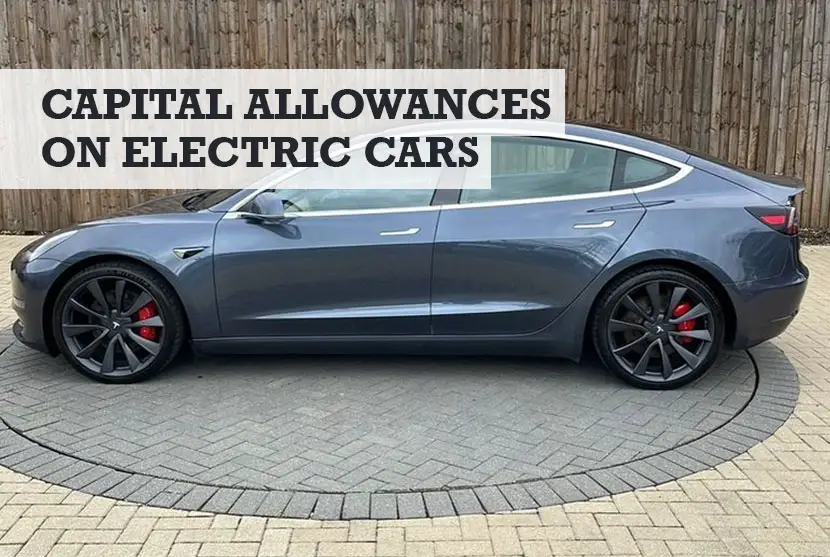As the shift toward sustainable transportation continues, electric cars are increasing in popularity with individuals and businesses. In addition to their environmental benefits, electric cars can offer financial advantages through capital allowances. In this guide, we will explain capital allowances on electric cars, plus whether they qualify for 100% capital allowances, the HMRC allowances, and the implications for used and hybrid electric cars.
In simple terms, and to answer your question about whether you can claim capital allowances on electrical cars, here’s the lowdown:
Yes, you can you claim capital allowances on electric cars. New and unused, electric cars bought from April 2021 can claim 100% first year allowances. Electric cars are eligible for 100% capital allowances, meaning the full cost of the car can be deducted from taxable profits in the year of purchase. This is known as the First Year Allowance (FYA) scheme, which encourages businesses to invest in low-emission vehicles by offering accelerated tax relief.
So, the short answer is, yes, from April 2021, electric cars get 100% capital allowances which you can claim. But this shouldn’t be your only factor when deciding whether an electric car is right for you. Second hand electric cars and hybrid cars could also be a consideration.
Below are the various scenarios below to help you understand the capital allowances on electric cars and hybrid cars.
Do electric cars get 100% capital allowances?
You can claim capital allowances on electric cars you buy and use in your business. This means you can deduct part of the value from your profits before you pay tax.
And yes, electric cars are eligible for 100% capital allowances, meaning the full cost of the car can be deducted from taxable profits in the year of purchase. This is known as the First Year Allowance (FYA) scheme, which encourages businesses to invest in low-emission vehicles by offering accelerated tax relief.
New and unused, electric cars bought from April 2021 can claim 100% first year allowances.
What is the capital allowance for buying electric car for a limited company?
The capital allowance for buying electric cars falls under the ECA scheme. It allows businesses to claim a 100% first-year allowance (FYA) on the purchase of new electric cars, enabling them to deduct the full cost from their taxable profits in the year of purchase.
Can you claim capital allowances on used electric cars?
While the Enhanced Capital Allowance (ECA) scheme primarily applies to new electric cars, there are capital allowance options for used electric cars. In most cases, used electric cars are eligible for the Annual Investment Allowance (AIA), which allows businesses to claim tax relief on a portion of the car’s cost over several years.
The Annual Investment Allowance (AIA) in the UK allows businesses to deduct the full value of qualifying capital items from their profits before tax. The AIA applies to most plant and machinery, which generally includes business vehicles.
Used electric cars can qualify for the AIA, but there are some conditions and exclusions:
Exclusions from AIA: Cars, in general, are excluded from AIA unless they are used in the business as:
- Taxis
- Driving school vehicles
- Hire cars
So, for many businesses, cars (whether electric or not) won’t qualify for AIA due to this general exclusion. However, the cars that meet the above conditions would qualify.
Low-emission vehicles and First Year Allowance (FYA): As mentioned previously, there was a 100% FYA available for new electric cars and certain low-emission vehicles. This is different from AIA. However, the FYA is specifically for new vehicles. Used electric cars wouldn’t qualify for FYA but might be eligible for writing down allowances.
Writing Down Allowances: If a vehicle (new or used) doesn’t qualify for AIA or FYA, it can still be eligible for writing down allowances, which spread the cost over several years. The rate at which these allowances can be claimed depends on the CO2 emissions of the car.
When you buy second hand, electric cars can claim capital allowances based on the main rate allowances for cars.
You can’t claim the 100% First Year Allowance (FYA) as it’s applicable only for new and unused cars. However, you would typically place the car in either the main rate pool or the special rate pool and claim a Writing Down Allowance (WDA) on it.
Example of claiming capital allowances on used electric cars, let’s assume:
The used electric car has been put in the main rate pool (for simplicity’s sake; the decision between pools would typically depend on CO2 emissions).
The Writing Down Allowance (WDA) for the main rate pool is 18% (this is based on the rates as of 2023).
Purchase of Used Electric Car:
Cost: £30,000
Year 1:
– Allowance: 18% of £30,000 = £5,400
– Remaining Value: £30,000 – £5,400 = £24,600
Year 2:
– Allowance: 18% of £24,600 = £4,428
– Remaining Value: £24,600 – £4,428 = £20,172
Year 3:
– Allowance: 18% of £20,172 = £3,630.96
– Remaining Value: £20,172 – £3,630.96 = £16,541.04
… And so on, until the value of the car is fully written off for tax purposes.
Each year, you can deduct the allowance from your taxable profits. So, in Year 1, you would reduce your taxable profits by £5,400, in Year 2 by £4,428, and so forth.
Do remember that this is a simplified example. In real-world scenarios, there might be other factors to consider, such as business use proportion if the vehicle isn’t used 100% for business, any trade-ins, or private use adjustments. Always consult with a tax professional to get a clear understanding and make accurate calculations.
Since tax rules and regulations can change, it’s essential to consult the latest guidelines from HMRC or seek advice from a tax professional when considering the purchase of used electric cars for business use. They can provide specific, up-to-date, and applicable information tailored to your situation.
What is the HMRC allowance for electric cars?
The HMRC (Her Majesty’s Revenue and Customs) provides several allowances for electric cars. The ECA scheme allows businesses to claim 100% capital allowances on new electric cars, while the Annual Investment Allowance (AIA) allows tax relief on the cost of used electric cars over a longer period.
Capital Allowances on electric cars in 2023/24
The specific capital allowances for electric cars in the 2023/24 tax year depend on the prevailing regulations and legislation at that time.
From April 2021 electric vehicles are eligible for 100% first year capital allowances. Electric vehicle charging points are also eligible for 100% allowances but don’t forget that the private use element should not be overlooked, and this may lead to the asset needing to be separately pooled for capital allowance purposes.
It is advisable to consult with the latest HMRC guidelines or seek professional advice for up-to-date information on capital allowances applicable to electric cars in the specific tax year.
First-year allowance on electric cars
The first-year allowance (FYA) is a type of capital allowance that allows businesses to claim the full cost of qualifying assets, such as electric cars, as a deduction from taxable profits in the year of purchase. Electric cars generally qualify for a 100% FYA under the ECA scheme.
The First Year Allowance (FYA) for electric cars, allows businesses in the UK to deduct the full cost of a qualifying car from their pre-tax profits in the year of purchase. Here’s a summary of the rules as they were then:
- Emission Rates: Cars that emit 0 grams of CO2/km (essentially, fully electric vehicles) were eligible for the 100% FYA. Moreover, cars that emit up to 50 grams of CO2/km and meet certain other criteria, like being able to travel a minimum distance solely on electric power, could also qualify.
- Exclusion from Main Pool: Cars that qualify for the FYA are excluded from the main pool of capital allowances. This means that if you claim the FYA, you cannot claim any other form of writing down allowance on that car.
- Not Mandatory: Claiming the FYA is optional. If a business chooses not to claim it, the car will enter either the main rate pool or the special rate pool, where writing down allowances can be claimed at the respective rates.
- End Date: The government had announced that the 100% FYA for low and zero-emission cars would end in April 2021 but later extended this date to 2025. This is to encourage businesses to choose environmentally friendly vehicles.
- Other Vehicles: Note that the FYA is not just for cars. It also applies to other types of assets. The rules and qualifying criteria might differ based on the type of asset.
- Charge-Point Equipment: FYA was also available for businesses that purchase electric vehicle charge-point equipment.
- Leased Cars: FYAs generally can’t be claimed on leased cars unless the business leasing the car is also the one that will bear the cost of the car’s depreciation.
Tax laws and incentives can change, reflecting the priorities and policies of the government. Thus, it’s essential to stay updated with any changes from the UK’s HM Revenue & Customs (HMRC) or to consult with a tax expert when considering the purchase of electric cars and other assets for business use.
You might also like: How to avoid paying tax on a company car.
FAQs on capital allowances for electric cars
Capital allowance on cars
You can claim capital allowances on cars you buy and use in your business. This means you can deduct part of the value from your profits before you pay tax.
Capital allowances on cars, including electric cars, allow businesses to claim tax relief on the cost of the vehicle. The specific allowances depend on the type of car, its emissions, and the prevailing regulations. Electric cars typically benefit from enhanced allowances due to their low emission nature.
Cars do not qualify for annual investment allowance (AIA).
Capital allowance rates for cars
You can claim one of the following:
- the full value of the car as 100% first year allowances
- 18% of the car’s value (main rate allowances)
- 6% of the car’s value (special rate allowances)
Which rate you can claim depends on when you bought the car and its CO2 emissions. Click here for info on how to check your car’s CO2 emissions.
Main and special rates apply from 1 April for businesses that pay Corporation Tax, and 6 April for businesses that pay Income Tax. The 100% first year allowances rate applies from 1 April for all businesses.
Capital allowances on Hybrid cars
Hybrid vehicles, which combine an internal combustion engine with an electric motor, produce fewer CO2 emissions than traditional petrol or diesel engines, making them eligible for various capital allowance rates.
Hybrid cars, including plug-in hybrid electric vehicles (PHEVs), may also qualify for capital allowances. The specific allowances depend on the car’s emissions and whether it meets the qualifying criteria for capital allowances. PHEVs with low emissions may be eligible for partial capital allowances.
If the vehicle has CO2 emissions of between 1 – 50 g/km from April 2021 the writing down allowance is 18% (Main Pool Allowance) per annum.
For vehicles above 50 g/km of CO2 the writing down allowance is 6% (Special Rate Pool) per annum.
Can I claim 100% capital allowances on an electric car?
Yes, in most cases, businesses can claim 100% capital allowances on the purchase of a new electric car under the ECA scheme. This means the full cost of the car can be deducted from taxable profits in the year of purchase, providing significant tax relief.
In the UK, businesses could claim a 100% First Year Allowance (FYA) for electric cars and certain low-emission vehicles. This means that businesses could deduct the full cost of the vehicle from their pre-tax profits in the first year after purchase, potentially resulting in significant tax savings.
However, the eligibility for this allowance is contingent on the vehicle’s emissions.
Cars with CO2 emissions of 0 grams per kilometre and which met certain other conditions (e.g., being capable of a minimum range when driven solely on electric power) were eligible for the FYA. 100% FYAs were also available for electric charge-point equipment.
| Cars bought from April 2021 | New and unused, CO2 emissions are 0g/km (or car is electric) | 100% first year allowances |
| Second hand electric car | Main rate allowances | |
| Cars bought between April 2018 and April 2021 | New and unused, CO2 emissions are 50g/km or less (or car is electric) | 100% first year allowances |
| Second hand electric car | Main rate allowances | |
| Cars bought between April 2015 and April 2018 | New and unused, CO2 emissions are 75g/km or less (or car is electric) | 100% first year allowances |
| Second hand electric car | Main rate allowances |
However, rules and regulations around taxes can change. Given the fast-paced developments in electric vehicle technologies and the changing landscape of incentives, it’s always advisable to check the most recent rules from the UK’s HM Revenue & Customs (HMRC) or consult with a tax expert to get the latest information on capital allowances for electric vehicles.
Conclusion
Capital allowances provide businesses with valuable tax relief when investing in electric cars. The Enhanced Capital Allowance (ECA) scheme allows for 100% capital allowances on new electric cars, enabling businesses to deduct the full cost from taxable profits in the year of purchase.
While used electric cars may be eligible for different capital allowance options, the Annual Investment Allowance (AIA) provides tax relief over several years. It is important to stay updated with the latest HMRC guidelines and consult with professionals to fully understand and maximise the capital allowances available for electric cars, ensuring both financial benefits and environmentally conscious business practices.

Jon has been in business since 1999, and in that time worked with more than 300 small business clients. As well as being an accountant, he is also an early adopter of tech, and has helped small businesses to leverage the power of their computer systems by creating software to automate and simplify accounting tasks.






